Feeling jittery about splashing out $1000 on a 3D printer? We’ve been there. We’ve pulled together a list of the best 3D printers under $1000, all certified winners sure to delight.
With $1000 in hand, you’re strutting confidently in prosumer territory. These are feature-rich, versatile machines, brimming with printing potential and broader material compatibility than your race-to-the-bottom variant printers. However, so much choice can murk the waters and feed indecisiveness.
The Best 3D Printers Under $1000
1. Flashforge Creator Pro 2
- Price: Check latest price at Flashforge here / Amazon here
- Build volume: 200 x 148 x 150 mm (with dual extruder)
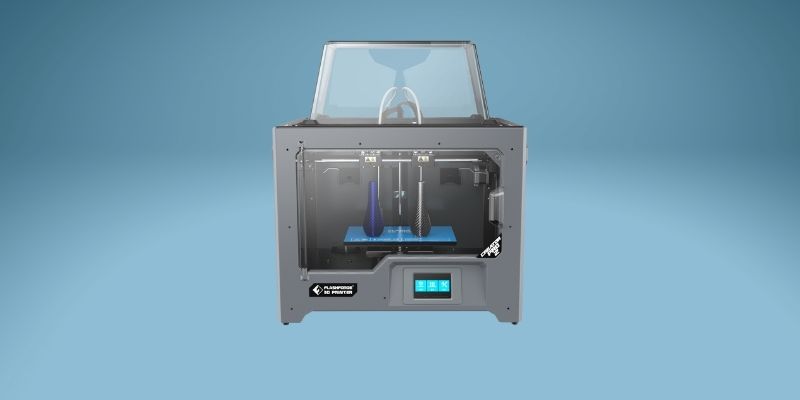
Pros
Brings the expensive possibilities of Independent Dual Extrusion to an affordable price.
Reliably delivers first-rate prints.
Exceptional print quality thanks to the fully enclosed chamber.
Cons
Build volume feels cramped.
Tied to the limited FlashPrint slicer.
A duly wrought upgrade of the original Creator Pro, the Flashforge Creator Pro 2 brings the expansive possibilities of Independent Dual Extrusion to a price point we can just about stomach. We’d generally expect to pay double for the chance to juggle different materials, colors, and support structures along with all manner of fancy dual print modes.
Put to the test, the Flashforge Creator Pro 2 reliably delivers first-rate prints, with a particular on neat splits when feeding different materials and colors through the IDEX. The print quality persists whether you’re using in PLA, HIPS, PVA, or ABS, with heat-sensitive filament fairing exceptionally well thanks to the fully enclosed chamber and the 120°C heated bed.
The build volume feels a tad cramped, especially in light of the IDEX setup, tallying up to 200 x 148 x 150 mm. Running two prints simultaneously effectively halves the printing area, hindering the production of large mirror parts, for example. But, the IDEX system makes up for this in droves.
Another minor gripe that needs pinpointing is FlashForge’s decision to tie the Creator Pro 2 to its functional, if a bit limiting, in-house FlashPrint slicer. As manufacturer slicers go, FlashPrint is among the better ones. However, we always feel underserved when we can’t fire up Cura or another third-party slicer teeming with advanced features.
Overall, makers who’ve grown beyond a starter printer, or first-timers in the market for some cost-effective printing thrills afforded by IDEX, will find the Flashforge Creator Pro 2 a worthwhile purchase.
Read more: the best dual extruder 3D printers
2. Prusa i3 MK3S+
- Price: Varies — available at Prusa store here or Amazon here / Pre-assembled — available at Prusa here or Amazon here
- Build volume: 250 x 210 x 210 mm
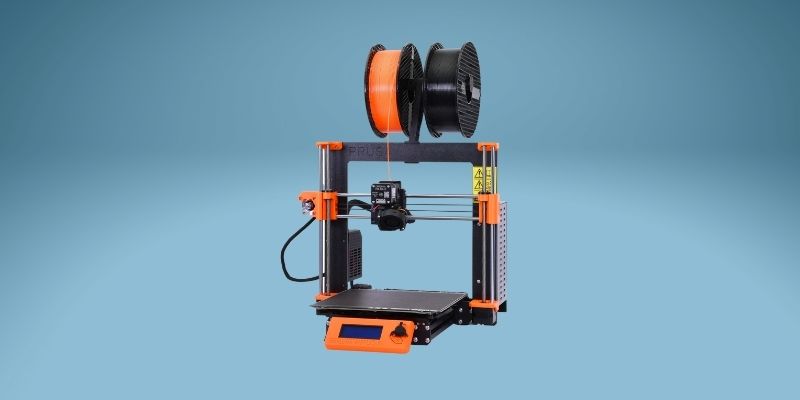
Pros
Sophisticated and easy to use.
Reliable and exquisite print quality.
Advanced mesh bed leveling.
Some good advanced features and power.
Cons
Some beginners will find the price too high.
Clad in distinctive orange and black, the Prusa i3 MK3S+ is a sophisticated yet easy-to-use printer that’s a regular feature atop best-of lists.
The Prusa i3 MK3S+ is a force in the 3D printing market, blending industry-leading hardware, integrated fail-safe tools and sensors that take much of the guesswork out of the trickier aspects of 3D printing, and reliable, exquisite print quality whatever the application.
You’ll find advanced mesh bed leveling courtesy of a SuperPinda probe and sleek power loss recovery should your power drop unexpectedly. The printer has coveted hardware like an E3D V6 hot end, an MK52″ heat bed, and removable PEI magnetic steels sheets textured to suit different materials.
These are just a slice of the tech and convenience features baked into the Prusa i3 MK3S+ that grant compatibility with PLA, ABS, flexibles, PETG, nylon, and more. The machine’s 250 x 210 x 210 mm build volume yields sufficient room for all the most common 3D printing applications, like hobby projects, prototyping, small-scale batch printing, and more.
Beginners may recoil at the steep asking price, but if you want to hit the ground running accompanied by a vibrant community of users and benchmark-setting customer support eager to help, the Prusa i3 MK3S+ plays in a league of its own.
There are enough advanced features and plenty of printing power roosting under the Prusa i3 MK3S+’s surface-level ease-of-use to delight more experienced makers and even professionals.
3. Qidi Tech X-Plus
- Price: Check price on Amazon here
- Build volume: 270 x 200 x 200 mm
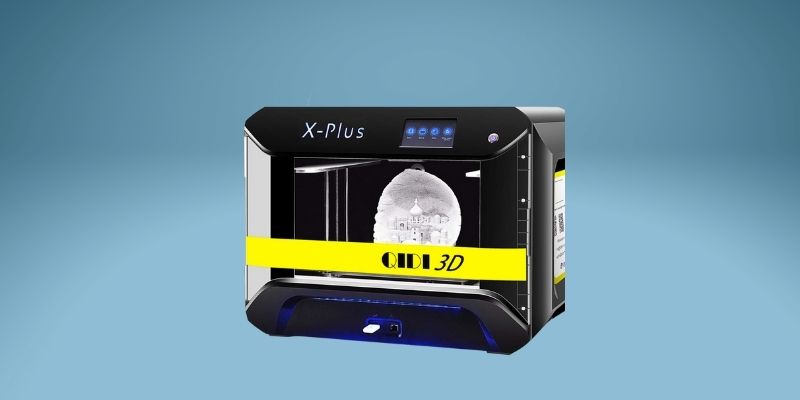
Pros
Combines affordability with the versatility usually reserved for more expensive printers.
Double-sided reversible heated bed.
Comes with a color touch screen, Wi-Fi connectivity, a dual Z-axis design, an air filtration system, and well-guided assisted bed leveling.
Cons
Workflow can take some getting used to.
The Qidi Tech X-Plus earns its keep alongside the best 3D printers under $1000 for combining affordability with the kind of versatility usually reserved for more expensive printers. The machine may be a tad short on the sophisticated flair found on competing printers but works so well with trickier materials it deserves more than a passing nod as exceptional value for money.
A clever dual interchangeable extruder setup is responsible for much of the Qidi Tech X-Plus’ versatility. It allows you to print equally well using PLA, PETG, TPU, and the like as heat-sensitive materials like ABS and nylon by fine-tuning each extruder to the correct temperature settings.
A double-sided reversible heated bed matches those attributes, each surface textured for either low-temperature materials or geared to offer the right adhesion for temperature-sensitive filament. The processing of different materials also extends to the enclosed chamber design: closed it maintains stable temperatures for ABS; with the covers removed, PLA has all the airflow needed for reliable prints.
A color touch screen, Wi-Fi connectivity, a dual Z-axis design, an air filtration system, well-guided assisted bed leveling, a decent 270 x 200 x 200 mm for medium-to-large parts, in-built dual spool holders, print resume, and more: the Qidi Tech X-Plus’ features tick many of the right boxes.
These make the Qidi Tech X-Plus an ideal printer for semi-professional power users searching for a good balance of affordability and versatility.
4. Pulse XE – great 3D printer under $1,000 for abrasive filament printing
- Price: $999 — Available at Matterhackers here
- Build volume: 250 x 220 x 215 mm
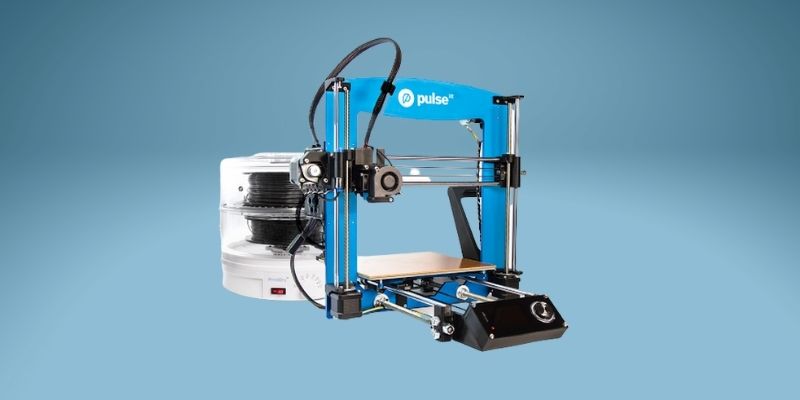
Pros
Makes easy work of even the trickiest, toughest, most demanding, and abrasive materials.
Prints quality parts using exotic filaments.
Comes with an E3D V6 hot end, a 300°C heated bed, and more.
Cons
Build volume is average.
A hulking beast of a machine, the Pulse XE is a slugger primed and ready to make easy work of even the trickiest, toughest, and most demanding and abrasive materials like NylonX, carbon fiber, brass, and more.
In many ways, it’s the seasoned maker’s modded dream machine, boasting the best in hardware and features without any time-consuming after-purchase tinkering at what is a reasonable price. Among them, the Pulse XE has an E3D V6 hot end, a 300°C heated bed with a genuine LayerLock Garolite surface, BLTouch bed leveling probe, Bondtech extruder, and a stocky all-metal frame.
Put to the test, it’s incredible just how easily the Pulse XE prints quality parts using exotic filaments. The machine just works, pumping out consistent prints day-in, day-out, fully deserving of its reliable workhorse reputation.
Although the Pulse XE is built to last and tackle the roughest printing projects, the physical footprint remains reasonable, balanced with an average 250 x 220 x 215 mm build volume. That printable area, while nothing extraordinary, should be enough for maker staples such as models, toys, functional household parts, light prototyping, and simultaneous multiple small part printing.
If you plan to churn out challenging parts and need a 3D printer that can keep up, we have no issues recommending the Pulse XE. It’s a machine that will likely take center stage in your printing setup in no time at all.
5. AnyCubic Photon Mono X 6K
- Price: Check latest price at Anycubic here / Amazon here
- Build volume: 192 x 120 x 245 mm
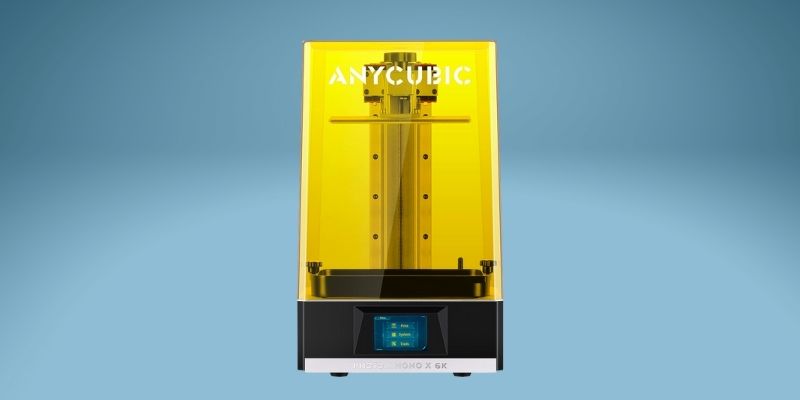
Pros
Combines exceptionally detailed 6K LCD with one of the biggest build volumes among resin 3D printers.
Can confidently cure up to 80 mm/h.
Good for printing large and high-fidelity prints.
Cons
Opt for a different printer if you don’t need the 6K LCD.
The AnyCubic Photon Mono X 6K remedies one of the main drawbacks of resin printing by combining an exceptionally detailed 6K LCD with one of the biggest build volumes among desktop resin 3D printers with no decline in print quality. Successfully supersizing resin printing without any trade-offs is the AnyCubic Photon Mono X 6K’s biggest appeal and solidifies its spot among the best 3D printers under $1000.
The 9.25-inch 6K monochrome LCD delivers an ultra-slim print resolution of 34 microns and a pixel resolution of 5760 x 3600. Over on the build plate, the AnyCubic Photon Mono X 6K gives you 192 x 120 x 245 mm of printable area to create decently-sized parts. Crank up the speed, and the printer can confidently cure up to 80 mm/h. In other words, the AnyCubic Photon Mono X 6K is no slouch when it comes to churning out parts.
AnyCubic has fostered a well-deserved reputation for selling resin printers with best-in-class print quality. The AnyCubic Photon Mono X 6K follows that lead, delivering truly exceptional parts, beautifully illustrating subtle features with a near-flawless finish. And, like its Photon siblings, the Mono X 6K is well-built and very easy to use, even though it lacks automatic bed leveling.
For makers looking to print large, high fidelity prints, the AnyCubic Photon Mono X 6K is a wise purchase, bound to deliver whether you’re a hobby model aficionado, tabletop gamer, professional prototyper, or small business.
Read more: the best resin 3D printers
6. Creality Ender 6
- Price: Check price at Creality official store here / Amazon here
- Build volume: 250 x 250 x 400 mm
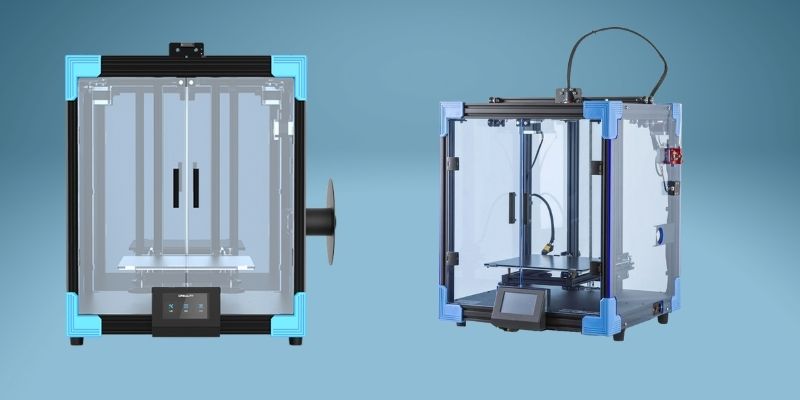
Pros
Prints at 150mm/h for a 100-micron layer height.
Good build volume.
Offers a solid basis for quality prints and plenty of scope for tinkering and modifications
Cons
Manual bed leveling, although you can accessorize with an automatic bed leveling probe.
Creality Ender 6’s arrives as a spiritual successor to the popular Creality Ender 5, mixing things up with a Core-XY machine outfitted to deliver considerably higher print speeds than most sub $1000 FDM printers. Pushed to the limit, the Creality Ender 6 prints at 150 mm/h for a 100-micron layer height, ideal for hobbyist and semi-professional applications.
Construction diverts from what you’d expect from FDM printers with a boxy all-metal frame surrounded by acrylic covers except for the top for a semi-enclosed chamber. Improvements over the Ender 5 include beefing up the build volume to 250 x 250 x 400 mm, which means more variety in the type of parts and models the Ender 6 can tackle.
Creality has also opted for a heated Carborundum glass platform, which helps with that finicky first layer adhesion. Quality of life features like a filament run-out sensor, print resume, touchscreen, and a silent motherboard chipset make it a user-friendly printer, too.
The Creality Ender 6 offers a solid basis for quality prints and plenty of scope for tinkering and modifications. For that reason, it hits our list as a top pick for veteran printers looking for a solid foundation to build on.
Read more: the best enclosed 3D printers
And: the best CoreXY 3D printers
Buyer’s Guide – What To Expect From a 3D Printer Under $1000
Intended Use
Be sure to choose a printer that will deliver on your printing plans and aims. If you want to create high-detail, high-fidelity miniatures, veer towards a high-resolution resin printer like the AnyCubic Photon Mono X 6K.
If you want a reliable prosumer printer you can use daily to experiment and print a wide variety of parts, then a versatile printer such as the Prusa i3 MK3S+ or Qidi Tech X-Plus is a solid pick. A speedy printer like the Creality Ender 6 makes more sense for a small business prototyping or batch printing parts for sale.
Build Volume
There’s generally a correlation between build volume and price; up either of these, the other follows. Fortunately, spending $1000 represents a sweet spot of sorts as the overwhelming majority of printers around this price have generously-sized build volumes.
If you plan to print more imposing parts or models in one sitting, then it’s worth considering printers with larger build volumes like the Qidi Tech X-Plus and Prusa i3 MK3S+.
Material Compatibility
At $1000, you should expect a printer to confidently tackle low-temp materials like PLA, PETG, and flexibles as standard with the possibility of ABS printing. Compatibility with both low and high-temperature grants more application variety. Look for printers with a mandatory enclosed design and possibly dual extruders for convenience if you want to print with a broader range of materials.
As for resin printers, you are tied to one material type, so there’s nothing, in particular, to look out for here other than decent support for third-party resins.
Print Speed, Resolution, and Layer Height
Print speed bundles together many factors, but look at mm/h on the spec sheet to get a sense of a printer’s capabilities.
On the upper end of the scale, you’ll find printers like Creality Ender 6 capable of a blistering 150 mm/h.
For resin printers, 60-80 mm/h is a solid starting point in the sub $1000 3D printer category, and should keep most print times to hours rather than days.
Dual Extruder
Though not exactly standard, printers with dual extruders or IDEX systems priced around $1000 are available such as the Qidi Tech X-Plus and Flashforge Creator Pro 2. They make printing with different material types and colors a breeze, removing the need to flush out an extruder and swap out filament.
If your plans involve complex, multi-color parts, mirroring printing, duplicate printing, and the like, we highly recommend dual extruder printers for the convenience factor.
Automatic Bed Leveling
Automatic bed leveling takes much of the frustration out of the unavoidable task of bed leveling, a crucial step in the setup process.
For $1000, the likelihood is that a printer sports automatic bed leveling or, at the very least, well-guided and straightforward assisted bed leveling. If the thought of hands-on leveling worries you, opt for a printer with no fuss auto-bed leveling like the Prusa i3 MK3S+ or Pulse XE.
Read more: the best auto-leveling 3D printers
Kit vs Pre-Assembled
3D Printers priced under $1000 generally ship pre-assembled, sometimes requiring a few simple maneuvers to complete the build. That said, you’ll find similarly priced kit printers such as the DIY version of the Prusa i3 MK3S+.
If you’re up for the challenge and want a crash course in the hardware underpinning a 3D printer, we highly recommend the kit route. Kit printers are also cheaper, so there are savings to be had there, too. If this is your first printer and you’re uneasy about manual building, you may want to find a printer that works out-of-the-box with little to no assembly.
Safety Functions
If you’re looking to acquire a printer for schools or other educational settings, it’s worth considering a printer’s safety features.
Top of the list are features such as an enclosed chamber that provides a barrier between the hot parts and fingers, an air filtration system to filter out toxic fumes, especially when printing ABS, and quality-of-life niceties like a print resume function, automatic filament feeding, and a filament runout sensor.
These are all standard features in the best 3D printers under $1000, but you may need to shop around to find a printer with just the right assortment of safety features to suit your needs. A shut-off sensor that triggers when the lid is removed should come as standard on a resin printer.
FAQ
Other 3D printer price range articles you may be interested in:
- Best 3D printers under $200
- Best 3D printers under $300
- Best 3D printers under $500
- Best 3D printers under $2000
- Best 3D printers under $5000





